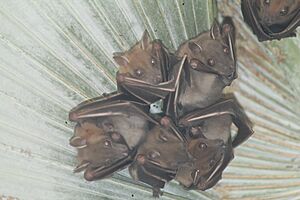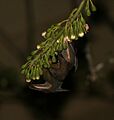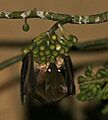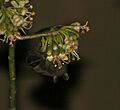Greater short-nosed fruit bat facts for kids
Quick facts for kids Greater short-nosed fruit bat |
|
|---|---|
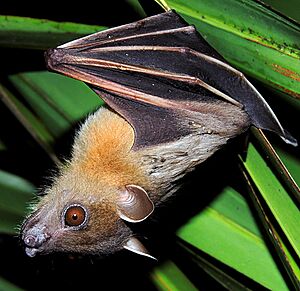 |
|
| Hanging over foliage palm in Mangaon, Maharashtra | |
| Conservation status | |
| Scientific classification | |
| Genus: |
Cynopterus
|
| Species: |
sphinx
|
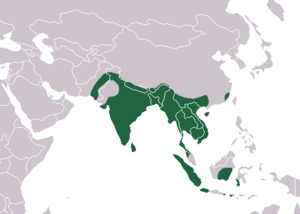 |
|
| Greater short-nosed fruit bat range | |
The greater short-nosed fruit bat (Cynopterus sphinx), also known as the short-nosed Indian fruit bat, is a type of large bat found in South and Southeast Asia. It belongs to the Pteropodidae family, which includes many fruit bats.
What They Look Like
These bats have a nose that is quite long for a bat. Their fur is very soft and silky. The top part of their body is brown to grey-brown, while their belly is lighter. Their ears and wing bones have white edges.
An adult bat's wings can spread about 48 centimeters (19 inches) wide. Young bats are usually lighter in color than adults. Their forearm, which is a key measurement for bats, is typically around 70 millimeters (2.8 inches) long.
Where They Live
You can find the greater short-nosed fruit bat from Pakistan all the way to Vietnam. They are common in warm, wet tropical forests and in areas where people grow fruit. They also live in grasslands and mangrove forests, which are coastal forests with trees that grow in salty water.
These bats usually make their homes high up in palm trees. They chew on the palm leaves to create simple "tents" for shelter. If palm trees are not available, they might build tents by weaving together leaves and twigs from vines that grow on buildings.
Behavior and Life Cycle
Greater short-nosed fruit bats like to live in groups. They usually roost, or rest, in groups of eight or nine bats of the same sex. Males and females stay in separate groups until it's time to mate. During the breeding season, their groups get bigger. About 6 to 10 males and 10 to 15 females will share a palm-frond tent. Males stay with the females for a while after mating, but then they go back to their all-male groups.
In Central India, these bats have babies twice a year. A female bat usually gives birth to one baby at a time. The first baby is born between October and March. The mother mates again right after giving birth, and a second baby is born in July. Pregnancy lasts about 3 to 5 months.
Newborn bats weigh around 13.5 grams (0.5 ounces) and have a wingspan of about 24 centimeters (9.4 inches). By the time they stop drinking milk at 4 weeks old, they weigh about 25 grams (0.9 ounces) and have wings that span 36 centimeters (14 inches). Female bats can start having babies when they are 5 to 6 months old, but males need to be about a year old before they can breed.
These bats are mostly fruit-eaters. They find their favorite fruits by smell. They are known to eat a lot, sometimes even more than their own body weight in one meal! Some of their favorite fruits include ripe guava, banana, chikoo, dates, and lychees.
Because they eat so much fruit, short-nosed fruit bats can cause a lot of damage to fruit crops. This means farmers sometimes see them as pests. These bats can also carry a serious disease called Japanese encephalitis, which can affect humans. However, they are also very helpful because they spread the seeds of date palms and help pollinate many flowers that bloom at night.
Recently, scientists have also seen these bats eating soil or earth, a behavior called geophagy. This might help them get important minerals or get rid of harmful things they've eaten. It shows how flexible these bats can be in their eating habits.
Gallery
-
Feeding on kapok (Ceiba pentandra) at night in Kolkata, West Bengal, India



